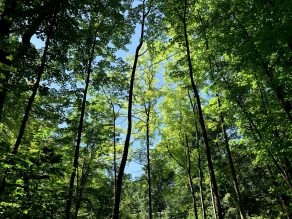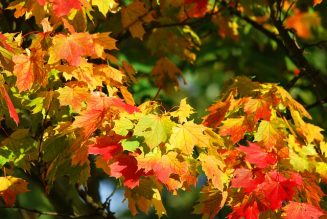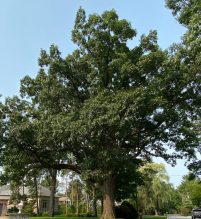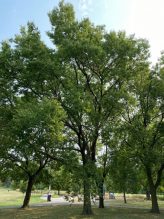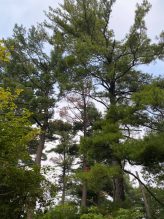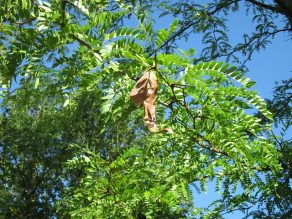Mississauga Celebrates the 10th Anniversary of One Million Trees Campaign
Environment | April 20, 2023
This year, the City is celebrating its 10th anniversary of the One Million Trees program. The program aims to add one million more trees to the Mississauga’s tree canopy by 2032. Since the program launched in 2013, more than 500,000 trees have been planted across Mississauga. Currently, there are approximately 2.1 million trees on public and private lands throughout the city.
Planting more trees helps increase canopy cover while restoring and enhancing Mississauga’s open spaces and forested areas for future generations to enjoy. Trees help filter out hazardous chemicals like carbon dioxide, increase Mississauga’s beauty through colourful blooms and leaves, and provide wildlife shelter, shade and food.
Since the program started in 2013:
- More than 500,000 trees have been planted.
- More than 37,000 volunteers have participated in tree plantings and woodland restoration events.
- A diverse mix of native trees have been planted including sugar maple, white pine, red oak and paper birch.
The City’s ultimate goal is to increase the tree canopy in parks, boulevards and natural areas and, in doing so, expand Mississauga’s natural heritage system and urban forest. The City is on track to meet its goal of planting one million trees by 2032.
Types of trees being planted in Mississauga
The City plants native trees which are indigenous to Southern Ontario, including sugar maple, white pine, red oak, paper birch, sycamore, tulip tree and shagbark hickory. When choosing tree species to plant, City staff look for the ideal planting environments for trees to survive. They also care for the trees through regular inspections, watering, re-mulching, pruning and weed removal.
Get involved and help plant more trees
All trees planted in Mississauga can contribute towards the one million trees goal. This includes the trees you plant on your property. When planting a tree or shrub, consider using native species since these are best suited to Mississauga’s climate and have the most benefit for the city’s native wildlife.
Tree-planting events happen throughout the year, so consider joining an upcoming event to engage with others in the community and help restore Mississauga’s parks. Everyone can participate, whether you’re a resident, business, school, homeowner or community group. If you don’t see an event in your neighbourhood, you can contact 311 (905-615-4311 outside City limits) and set up a tree planting event.
Looking to celebrate One Million Trees’ 10th anniversary on Earth Day? Come out and celebrate by joining the One Million Trees 10-Year community celebration. On Saturday, April 22, you can stop by Willowvale Fields from noon to 2 p.m. to join in family-friendly activities and to meet sustainable vendors.
For more information on the One Million Trees program, visit: onemilliontrees.ca.
For more information about One Million Trees events on Earth Day, visit: mississauga.ca/earth-days.
BACKGROUND
Types of trees commonly found in Mississauga
Mississauga has 2.1 million trees on both public and private lands including coniferous, deciduous, flowering and fruit trees. Some of Mississauga’s most common trees include:
Maple: As Canada’s arboreal emblem, Mississauga is home to many species of maple trees like sugar maples and red maples, which are native to Ontario. Mississauga also has Norway maples, which have been introduced from Europe. Many maple trees have green leaves in the spring and summer. In the fall, they have a range of colours like golden yellow, orange or red, depending on the species.
Oak: Oak trees do not shed their leaves, and you can often see their leaves throughout the winter. Instead, they rely on the wind to blow off their dead leaves to help with new growth. In the spring and summer, the leaves are a glossy green. In the fall, they turn red or golden brown. They are very distinct because of their acorns.
Hackberry: This is a small but fast-growing tree native to southern Ontario. It has a broad, round, irregular-shaped crown that allows just enough sunlight to break through to the ground below. This allows grass and flowers to grow underneath the tree. Its light green leaves turn yellow in the fall. It has small reddish-purple fruits that hang below the leaves. These fruits are an important food source for several birds, mammals and pollinator
Eastern White Pine: The eastern white pine is the provincial tree of Ontario. It’s also the tallest tree in Mississauga and Ontario. It can live for more than 250 years. It’s a fast-growing, medium-sized pine tree and the only one of its species with soft feathery needles in clusters of five. They’re often used as a perch for birds and provide immense ecological diversity benefits to Mississauga’s woodlands. Being an evergreen tree, the needles don’t shed every year – they usually remain on the tree for one to four years.
Honey Locust: The honey locust tree is a strong tree that is well suited to urban areas and mostly found on Mississauga’s streets and boulevards. The leaf is dull green with a pale underside that folds or curls in the rain or at night. Its leaves turn yellow in the fall, with huge, curved, twisted fruit pods that provide food for wildlife like squirrels and deer.
Tags
Media contact
City of Mississauga Media Relations
media@mississauga.ca
905-615-3200, ext. 5232
TTY: 905-896-5151
